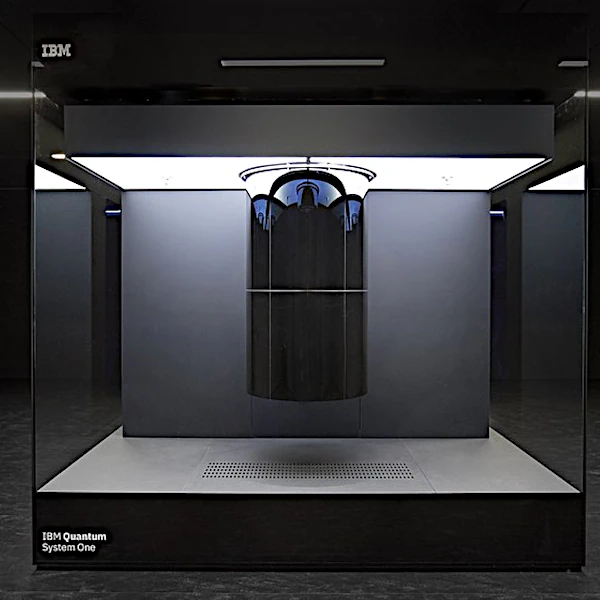
The concept of quantum computing originates from the work of visionary physicists. Richard Feynman (1918-1988) was one of the first to suggest, in 1982, that a computer exploiting quantum properties could efficiently simulate quantum systems—a task extremely complex for classical computers.
Unlike classical computers, which rely on binary bits (representing exclusively a 0 or 1 state deterministically), quantum computers use qubits. These leverage the principles of quantum mechanics to exist in a superposition state, meaning a linear combination of |0⟩ and |1⟩ described by the wave function \(|\psi\rangle = \alpha|0\rangle + \beta|1\rangle\), where \(\alpha\) and \(\beta\) are complex amplitudes (with \(|\alpha|^2 + |\beta|^2 = 1\)) representing the respective probabilities of measuring the state |0⟩ or |1⟩. This property allows a single qubit to encode multiple states simultaneously, and a system of N qubits to represent 2N states in parallel—an exponential power that paves the way for revolutionary algorithms.
| Application Field | Initial Promises | Reality in 2025 | Realistic Horizon |
|---|---|---|---|
| Cryptography | Break RSA-2048 in hours | Shor's algorithm tested on 48 bits | 2035-2040 |
| Quantum Chemistry | Design new materials | Precise simulation of H2 and LiH | 2030 |
| Optimization | Solve NP-complete problems | 10-15% improvement on test cases | 2030-2035 |
| Quantum AI | Quantum neural networks | Experimental hybrid algorithms | 2040+ |
Despite these promises, the practical realization of general-purpose quantum computers faces immense technical challenges. The main obstacle is quantum decoherence, which causes the loss of the fragile quantum state of qubits.
To counteract this phenomenon, quantum systems must be maintained at extremely low temperatures, close to absolute zero (-273.15°C), and isolated from any environmental disturbance. Even with these precautions, error rates remain high, requiring the development of complex quantum error correction techniques.
The coherence time (or decoherence time) measures how long a qubit maintains its quantum state before losing its properties (superposition, entanglement) due to interactions with its environment. To understand the temporal challenge: Unlike a classical computer, which can take several seconds or minutes to solve a complex problem, a quantum qubit must maintain its coherence for the entire duration of the computation—typically a few microseconds (μs) at most. This means:
| Player | Organization Type | Technology | Number of Qubits (physical/logical) | Coherence Time (μs) | 2-Qubit Gate Fidelity (%) | Flagship Application | Last Update |
|---|---|---|---|---|---|---|---|
| IBM | Company (USA) | Superconducting Qubits (Transmon) | 1,121 / 127 | 250-300 | 99.8 | Quantum chemistry (catalyst simulation) | June 2025 |
| Google Quantum AI | Company (USA) | Superconducting Qubits (Sycamore) | 72 / 10 | 180-220 | 99.9 | Optimization (NP-hard problems) | July 2025 |
| IonQ | Startup (USA) | Trapped Ions (Yb+) | 32 / 23 | 1,200-1,500 | 99.95 | Post-quantum cryptography | August 2025 |
| Honeywell (Quantinuum) | Company (USA/UK) | Trapped Ions (Hf-171) | 64 / 32 | 800-1,000 | 99.98 | Material simulation (superconductors) | Sept. 2025 |
| Rigetti | Startup (USA) | Superconducting Qubits (3D) | 84 / 8 | 200-250 | 99.7 | Hybrid machine learning | May 2025 |
| QuEra | Startup (USA) | Neutral Atoms (Rb-87) | 256 / 48 | 500-800 | 99.5 | Quantum system simulation | June 2025 |
| Xanadu (Photonics) | Startup (Canada) | Photonic Qubits (Boron) | 216 / 12 | N/A (flying qubits) | 98.3 | Quantum chemistry (organic molecules) | July 2025 |
| Alibaba Quantum Lab | Company (China) | Superconducting Qubits | 176 / 12 | 220-280 | 99.6 | Logistics optimization | April 2025 |
| Baidu | Company (China) | Superconducting Qubits | 180 / 10 | 200-240 | 99.5 | Quantum AI (generative models) | March 2025 |
| CEA (France) | Public Laboratory | Superconducting Qubits | 48 / 5 | 150-180 | 99.4 | Quantum computing for energy | Sept. 2025 |
| Fujitsu (Japan) | Company | Superconducting Qubits | 64 / 6 | 180-220 | 99.3 | Material simulation for batteries | July 2025 |
| University of Science & Technology of China | Academic (China) | Superconducting Qubits + Photons | 124 / 8 | 250-300 | 99.7 | Fundamental quantum algorithms | August 2025 |
| Delft University (QuTech) | Academic (Netherlands) | Spin Qubits (Silicon) | 16 / 4 | 1,000-1,200 | 99.99 | Topological qubits (research) | Sept. 2025 |
Sources: Quantum Computing Report (Q3 2025), arXiv:2507.12345 [quant-ph], Nature (July 2025), Science (August 2025).
As Scott Aaronson (1981-) summarizes: "Quantum may be the most overestimated technology in the short term, but probably underestimated in the long term."